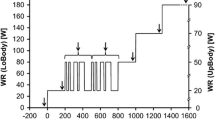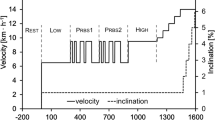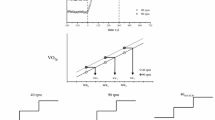Abstract
Purpose
The aim of the study was to compare the kinetics responses of heart rate (HR), pulmonary (\(\dot{V}\)O2pulm), and muscular (\(\dot{V}\)O2musc) oxygen uptake during dynamic leg exercise across different body positions (−6°, 45°, and 75°).
Methods
Ten healthy individuals [six men, four women; age 23.4 ± 2.8 years; height 179.7 ± 8.3 cm; body mass 73 ± 12 kg (mean ± SD)] completed pseudo-random binary sequence (PRBS) work rate (WR) changes between 30 and 80 W in each posture. HR was measured beat-to-beat by echocardiogram and \(\dot{V}\)O2pulm by breath-by-breath gas exchange. \(\dot{V}\)O2musc kinetics were assessed by the procedure of Hoffmann et al. (Eur J Appl Physiol 113:1745–1754, 2013) applying a circulatory model and cross-correlation functions (CCF).
Results
For \(\dot{V}\)O2pulm kinetics significant differences between −6° (CCF-values: 0.292 ± 0.040) and 45° (0.256 ± 0.034; p < 0.01; n = 10) as well as between −6° and 75° (0.214 ± 0.057; p < 0.05; n = 10) were detected at lag ‘40 s’ of the CCF course as interaction effects (factors: Lag × Posture). HR and \(\dot{V}\)O2musc kinetics yield no significant differences across the postures.
Conclusions
The analysis of cardio-dynamic and respiratory kinetics, especially with an emphasis on muscular and cellular level, has to consider venous return and cardiac output distortions. Simplified observations of kinetics responses resulting in time constants and time delays only should be replaced by the time-series analysis for a more sophisticated evaluation. The results illustrate that isolated \(\dot{V}\)O2pulm measurements without cardio-dynamic influences may not represent the kinetics responses originally revealed at muscular level.




Similar content being viewed by others
Abbreviations
- BCM:
-
Backward-calculation model
- CCF:
-
Cross-correlation function
- CCFlag [s]:
-
Lag of CCFmax
- CCFmax [a.u.]:
-
Maximum (peak) of cross-correlation function
- CPET:
-
Cardio-pulmonary exercise testing
- HDT:
-
Head-down tilt
- HR [min−1]:
-
Heart rate
- LTI:
-
Linear time-invariant model
- PRBS:
-
Pseudo random binary sequence
- \(\dot{Q}\) [L min−1]:
-
Cardiac output
- \(\dot{Q}\) rem [mL min−1]:
-
Perfusion of non-exercising tissues
- SV [mL]:
-
Stroke volume
- τ [s]:
-
Time constant of mono-exponential function
- TD [s]:
-
Time delay of mono-exponential function
- \(\dot{V}\)O2max [L min−1]:
-
Maximal oxygen uptake capacity
- \(\dot{V}\)O2musc [L min−1]:
-
Exercising muscle oxygen uptake
- \(\dot{V}\)O2pulm [L min−1]:
-
Pulmonary oxygen uptake
- \(\dot{V}\)O2rem [L min−1]:
-
Oxygen uptake in non-exercising tissues
- V v [mL]:
-
Venous volume
- WR [W]:
-
Work rate
References
Barstow TJ, Molé PA (1987) Simulation of pulmonary O2 uptake during exercise. J Appl Physiol 63:2253–2261
Barstow TJ, Lamarra N, Whipp BJ (1990) Modulation of muscle and pulmonary O2 uptakes by circulatory dynamics during exercise. J Appl Physiol 68:979–989
Beaver WL, Lamarra N, Wasserman K (1981) Breath-by-breath measurement of true alveolar gas exchange. J Appl Physiol 51:1662–1675
Behnke BJ, Barstow TJ, Kindig CA, McDonough P, Much TI, Poole DC (2002) Dynamics of oxygen uptake following exercise onset in rat skeletal muscle. Respir Physiol Neurobiol 133:229–239
Benson AP, Grassi B, Rossiter HB (2013) A validated model of oxygen uptake and circulatory dynamics interactions at exercise onset in humans. J Appl Physiol 115:743–755
Capelli C, Antonutto G, Cautero M, Tam E, Ferretti G (2008) Metabolic and cardiovascular responses during sub-maximal exercise in humans after 14 days of head-down tilt bed rest and inactivity. Eur J Appl Physiol 104:909–918
Capelli C, Adami A, Antonutto G, Cautero M, Tam E (2009) Oxygen deficits and oxygen delivery kinetics during submaximal intensity exercise in humans after 14 days of head-down tilt-bed rest. Eur J Appl Physiol 107:51–59
Cautero M, Di Prampero PE, Capelli C (2003) New acquisitions in the assessment of breath-by-breath alveolar gas transfer in humans. Eur J Appl Physiol 90:231–241
Chang AT, Boots RJ, Brown MG, Paratz JD, Hodges PW (2005) Ventilatory changes following head-up tilt and standing in healthy subjects. Eur J Appl Physiol 95:409–417
Cochrane JE, Hughson RL (1992) Computer simulation of O2 transport and utilization mechanisms at the onset of exercise. J Appl Physiol 73:2382–2388
DiMenna FJ, Wilkerson DP, Burnley M, Bailey SJ, Jones AM (2010) Priming exercise speeds pulmonary O2 uptake kinetics during supine “work-to-work” high-intensity cycle exercise. J Appl Physiol 108:283–292
Drescher U, Koschate J, Hoffmann U (2015) Oxygen uptake and heart rate kinetics during dynamic upper and lower body exercise: an investigation by time-series analysis. Eur J Appl Physiol 115:1665–1672
Egaña M, Columb D, O’Donnell S (2013) Effect of low recumbent angle on cycling performance, fatigue, and VO2 kinetics. Med Sci Sports Exerc 45:663–673
Eßfeld D, Hoffmann U, Stegemann J (1987) V’O2 kinetics in subjects differing in aerobic capacity: investigation by spectral analysis. Eur J Appl Physiol Occup Physiol 56:508–515
Eßfeld D, Hoffmann U, Stegemann J (1991) A model for studying the distortion of muscle oxygen uptake patterns by circulation parameters. Eur J Appl Physiol Occup Physiol 62:83–90
Ferretti G, Antonutto G, Denis C, Hoppeler H, Minetti AE, Narici MV, Desplanches D (1997) The interplay of central and peripheral factors in limiting maximal O2 consumption in man after prolonged bed rest. J Physiol 501:677–686
Fortin J, Habenbacher W, Heller A, Hacker A, Grüllenberger R, Innerhofer J, Passatzh H, Wagner C, Haitchi G, Flotzinger D, Pacher R, Wach P (2006) Non-invasive beat-to-beat cardiac output monitoring by an improved method of transthoracic bioimpedance measurement. Comput Biol Med 36:1185–1203
Grassi B, Poole DC, Richardson RS, Knight DR, Erickson BK, Wagner P (1996) Muscle O2 uptake kinetics in humans: implications for metabolic control. J Appl Physiol 80:988–998
Grassi B, Gladden LB, Samaja M, Stary CM, Hogan MC (1998a) Faster adjustments of O2 delivery does not affect \(\dot{V}\)O2 on-kinetics in isolated in situ canine muscle. J Appl Physiol 85:1394–1403
Grassi B, Gladden LB, Stary CM, Wagner PD, Hogan MC (1998b) Peripheral O2 diffusion does not affect \(\dot{V}\)O2 on-kinetics in isolated in situ canine muscle. J Appl Physiol 85:1404–1412
Hoffmann U, Drescher U, Benson AP, Rossiter HB, Essfeld D (2013) Skeletal muscle V’O2 kinetics from cardio-pulmonary measurements: assessing distortions through O2 transport by means of stochastic work-rate signals and circulatory modelling. Eur J Appl Physiol 113:1745–1754. doi:10.1007/s00421-013-2598-7
Hoffmann U, Moore AD, Koschate J, Drescher U (2016) Influence of Weightlessness on aerobic capacity, cardiac output and oxygen uptake kinetics. In: Stefan Schneider (Ed) Exercise in space—A Holistic Approach for the Benefit of Human Health on Earth. SpringerBriefs in Space Life Sciences. doi:10.1007/978-3-319-29571-8
Hughson RL, Cuervo LA, Patla AE, Winter DA, Xing HC, Dietrich BH, Swanson GD (1991) Time domain analysis of oxygen uptake during pseudorandom binary sequence exercise tests. J Appl Physiol 71:1620–1626
Hughson RL, Cochrane JE, Butler GC (1993) Faster O2 uptake kinetics at onset of supine exercise with than without lower body negative pressure. J Appl Physiol 75:1962–1967
Jacobs PL, Nash MS (2004) Exercise recommendations for individuals with spinal cord injury. Sports Med 34:727–751
Koga S, Shiojiri T, Shibasaki M, Kondo N, Fukuba Y, Barstow TJ (1999) Kinetics of oxygen uptake during supine and upright heavy exercise. J Appl Physiol 87:253–260
Lador F, Kenfack MA, Moia C, Cautero M, Morel DR, Capelli C, Feretti G (2006) Simultaneous determination of the kinetics of cardiac output, systemic O2 delivery, and lung O2 uptake at exercise onset in men. Am J Physiol Regul Integr Comp Physiol 290:R1071–R1079
Lai N, Dash RK, Nasca MM, Saidel GM, Cabrera ME (2006) Relating pulmonary oxygen uptake to muscle oxygen consumption at exercise onset: in vivo and in silico studies. Eur J Appl Physiol 97:380–394
Lai N, Camesasca M, Saidel GM, Dash RK, Cabrera ME (2007) Linking pulmonary oxygen uptake, muscle oxygen utilization and cellular metabolism during exercise. Ann Biomed Eng 35:956–969
Lee S, Moore AD, Everett ME, Stenger MB, Platts SH (2010) Aerobic exercise deconditioning and countermeasures during bed rest. Aviat Space Environ Med 81:52–63
MacDonald MJ, Shoemaker JK, Tschakovsky ME, Hughson RL (1998) Alveolar oxygen uptake and femoral artery blood flow dynamics in upright and supine leg exercise in humans. J Appl Physiol 85:1622–1628
Perell KL, Gregor S, Kim G, Rushatakankovit S, Scremin AE, Levin S, Gregor R (2002) Comparison of cycling kinetics during recumbent bicycling in subjects with and without diabetes. J Rehabil Res Dev 39:13–20
Pivarnik JM, Ayres NA, Mauer MB, Cotton DB, Kirshon B, Dildy GA (1993) Effects of maternal aerobic fitness on cardiorespiratory responses to exercise. Med Sci Sports Exerc 25:993–998
Poole DC, Gaesser GA, Hogan MC, Knight DR, Wagner PD (1992) Pulmonary and leg VO2 during submaximal exercise: implications for muscular efficiency. J Appl Physiol 72:805–810
Pringle JS, Doust JH, Carter H, Tolfrey K, Campbell IT, Jones AM (2003) Oxygen uptake kinetics during moderate, heavy and severe intensity ‘submaximal’ exercise in humans: the influence of muscle fibre type and capillarisation. Eur J Appl Physiol 89:289–300
Rowell LB (1993) Human cardiovascular control. Oxford University Press, USA
Scott A, Antonishen K, Johnston C, Pearce T, Ryan M, Sheel AW, McKenzie DC (2006) Effect of semirecumbent and upright body position on maximal and submaximal exercise testing. Meas Phys Educ Exerc Sci 10:41–50
Shibata S, Perhonen M, Levine BD (2010) Supine cycling plus volume loading prevent cardiovascular deconditioning during bed rest. J Appl Physiol 108:1177–1186
Stegemann J, Essfeld D, Hoffmann U (1985) Effects of a 7-day head-down tilt (−6 degrees) on the dynamics of oxygen uptake and heart rate adjustment in upright exercise. Aviat Space Environ Med 56:410–414
Trappe T, Trappe S, Lee G, Widrick J, Fitts R, Costill D (2006) Cardiorespiratory responses to physical work during and following 17 days of bed rest and spaceflight. J Appl Physiol 100:951–957
Wagner PD (2011) Modeling O2 transport as an integrated system limiting. Comput Methods Programs Biomed 101:109–114
Walsh-Riddle M, Blumenthal JA (1989) Cardiovascular responses during upright and semi-recumbent cycle ergometry testing. Med Sci Sports Exerc 21:581–585
Yoshida T, Abe D, Fukuoka Y, Hughson RL (2008) System analysis for oxygen uptake kinetics with step and pseudorandom binary sequence exercise in endurance athletes. Meas Phys Educ Exerc Sci 12:1–9
Zhou H, Saidel GM, Cabrera ME (2007) Multi-organ system model of O2 and CO2 transport during isocapnic and poikilocapnic hypoxia. Resp Physiol Neurobiol 156:320–330
Zhou H, Lai N, Saidel GM, Cabrera ME (2008) Multi-scale model of O2 transport and metabolism. Ann N Y Acad Sci 1123:178–186
Zhou H, Lai N, Saidel GM, Cabrera ME (2009) Multiscale modeling of respiration. Eng Med Biol Mag 28:34–40
Acknowledgments
The study was supported by the German Space Agency (DLR—Deutsches Zentrum für Luft- und Raumfahrt, FKZ 50WB0726 and FKZ 50WB1426). We thank Anna Bergner for support during the exercise tests and for data preparation.
Author information
Authors and Affiliations
Corresponding author
Ethics declarations
Conflict of interest
The authors declare that they have no conflict of interest.
Additional information
Communicated by Guido Ferretti.
Rights and permissions
About this article
Cite this article
Drescher, U., Koschate, J., Schiffer, T. et al. Analysis of cardio-pulmonary and respiratory kinetics in different body positions: impact of venous return on pulmonary measurements. Eur J Appl Physiol 116, 1343–1353 (2016). https://doi.org/10.1007/s00421-016-3386-y
Received:
Accepted:
Published:
Issue Date:
DOI: https://doi.org/10.1007/s00421-016-3386-y




